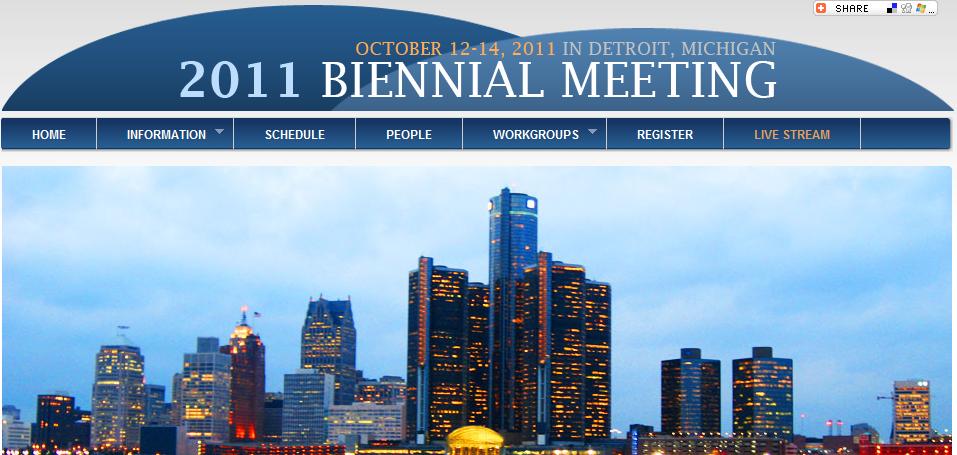Report & Conference: Assessing Great Lakes Health and Future — Al Gore Delivers Keynote
In Detroit last week, three organizations involved in Great Lakes management held concurrent and joint meetings to discuss the future of one of the world’s largest sources of fresh surface water. Former Vice President Al Gore delivered the keynote address, linking climate change to water issues.
On October 13, at its biennial meeting, the International Joint Commission (IJC), which manages waters shared by the United States and Canada, released a draft report describing progress made since 1987 toward the goals of the Great Lakes Water Quality Agreement. That agreement — signed in 1972 and updated in 1987 — is being renegotiated by Canada’s Ministry of the Environment (MOE) and the U.S. Environmental Protection Agency (EPA).
The report assessed 14 indicators of hydrological health, separated into chemical, biological, and physical categories:
- Most of the seven chemical indicators showed significant declines over the last three decades. Levels of PCBs, DDT, and heavy metals have decreased in soils, bird eggs, and mussels, but mercury levels have remained stable or have risen slightly. Although total phosphorous concentrations in nearshore waters have decreased, some forms have increased, leading to algal blooms.
- The six biological indicators showed mixed results. Some native aquatic species have remained stable or are growing, but 34 non-native species have been introduced.
- The one physical indicator appeared negative. Surface water temperatures are rising, and higher temperatures, along with agricultural runoff and a season of intense rainstorms, are assumed to have contributed to the record algae bloom this summer in western Lake Erie.
— Detroit News
The conference also put the spotlight on a new threat — what the technical jargon has dubbed “chemicals of emerging concern.” This is a group of chemicals comprising known to disrupt the endocrine system, including pesticides, medicines, household products (such as detergents), and personal-care products (such as cosmetics).
Several weeks before the conference, the IJC had released a report reviewing the scientific studies on the incidence of these chemicals in the Great Lakes. Scores of compounds have been identified so far.
According to Nick Schroeck — executive director of the Great Lakes Environmental Law Center who attended the biennial IJC meeting — water managers will have to understand two things: which chemicals are present and at what levels they are harmful to people and aquatic life.
Full Disclosure?
Despite the release of the progress report last week in Detroit, some lake watchers are concerned that the MOE and the EPA have not shared the text of the negotiating treaty, according to Schroeck, who also sat on a panel at the concurrent Healing Our Waters conference, a meeting of environmental groups, also being held in Detroit that weekend.
— Nick Schroek,
GL Environmental Law Center
“In a conference about cooperation and shared vision,” Schroeck told Circle of Blue, “I thought it a glaring example of some things still being kept behind closed doors.”
Speaking as a Great Lakes advocate, Schroeck said that he was pleased to see all the relevant parties gathered in the same arena. The event even drew former Vice President Al Gore for the keynote address. In his talk at Wayne State University, Gore linked climate change to the region’s water issues, according to the Detroit News.
The IJC meeting addressed lingering problems, such as water and soil contamination from the region’s industrial past. Schroeck felt it was encouraging that the federal government showed significant attention and willingness to invest in cleaning up pollution. Federal involvement for the 30 priority areas on the U.S. side of the border is necessary, he said, because many of the companies that dumped the waste no longer exist.
Brett writes about agriculture, energy, infrastructure, and the politics and economics of water in the United States. He also writes the Federal Water Tap, Circle of Blue’s weekly digest of U.S. government water news. He is the winner of two Society of Environmental Journalists reporting awards, one of the top honors in American environmental journalism: first place for explanatory reporting for a series on septic system pollution in the United States(2016) and third place for beat reporting in a small market (2014). He received the Sierra Club’s Distinguished Service Award in 2018. Brett lives in Seattle, where he hikes the mountains and bakes pies. Contact Brett Walton









Leave a Reply
Want to join the discussion?Feel free to contribute!